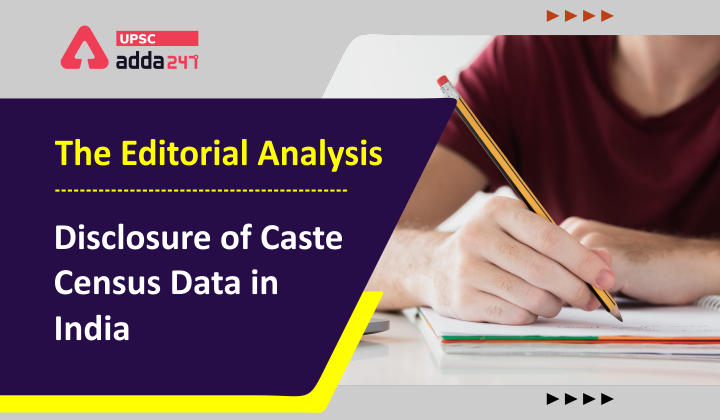Socio-Economic & Caste Census(SECC): Should a fresh Count & Disclosure be Made?
GS Paper – 1 & GS Paper – 2
Topics covered: Government Policies & Interventions; Social Empowerment
Context:
The government of India has cleared that no caste census will be made in the forthcoming census exercise in 2022, citing the impracticability of full caste enumeration & overwhelming operational difficulties.
Background:
In an affidavit filed in the Supreme Court on September 23, the Union government has ruled out conducting a Socio-Economic Caste Census (SECC), stating that a caste census (except that for the Scheduled Castes and the Scheduled Tribes done traditionally) was unfeasible, “administratively difficult and cumbersome”. The affidavit was in response to a writ petition by the Maharashtra government seeking directions to the Union government to collect data on the Backward Class of Citizens (BCC) of rural India during the enumeration of the 2021 census.
Why is the government against the Caste Census?
- Administrative, operational and logistical reasons.
- The Census exercise itself is transferred to the year 2022 due to Covid-19 and after-effects so it is unfeasible to go for a burdensome caste census and attempting it could endanger the census exercise itself.
- The difference in caste categories according to different lists. While the Central list contained 2,479 OBC castes, there were 3,150 OBC castes as per the lists of all the States and Union Territories taken together.
- In India, people use their clan/gotra, sub-caste and caste names interchangeably”. In such a complicated situation it’s not possible to get credible data.
- Since enumerators are part-timers with 6-7 days of training and not an investigator or it would be difficult to meaningfully tabulate and classify caste returns.
- The preparatory work for a census starts three to four years earlier. As for the census, the questionnaires have already been finalised and field-tested. It is, therefore, not possible to add additional questions about caste now.
- Unlike in the case of the SCs and the STs, there is no constitutional mandate for the Registrar-General and Census Commissioner, India, to provide the census figures of the OBCs and the BCCs.
- The government has cited the 2014 Supreme Court judgment setting aside two orders of the Madras High Court directing the Centre to conduct a caste census. As per this Supreme Court judgment, what information to collect in a census is a policy decision of the government, and while the court may find a certain policy untenable, it was “legally impermissible” for the court to dictate to the government what policy it ought to follow.
Arguments of those demanding a caste census?
- Open Caste data will justify the extension of reservations to various communities.
- There is a large body of scholarly work, done by sociologists, political scientists and historians, which bypass the welfare argument to assert that India’s fundamental mistake in its battle to overcome caste was not doing a caste census.
- They argue that in order to abolish caste, it is essential to first abolish caste-derived privileges, and in order to do that, the state must first map castes and their socio-economic status privileges/deprivations, which is what a caste census seeks to do.
- The government argues that the judiciary cannot direct the government to conduct a caste census because it is a “policy decision” not to do so, and the judiciary cannot interfere with government policy.
- However, Article 15(4) and 15(5) of the Indian Constitution have explicitly recognized socially and educationally backward classes of citizens as a category distinct from SC’s and ST’s and enabled to make special provisions for their advancement. So it is much under the Constitutional framework.
Status of the data collected under the SECC-2011?
- SECC-2011’s caste data of 130 crore Indians have been with the Ministry of Social Justice and Empowerment for five years.
- Due to flaws in the data, it was decided to form an expert committee headed by the then Vice-Chairman of the NITI Aayog, Arvind Panagariya. But since other members of the committee were not named, the committee never met, and as a result, no action was taken on the raw data to collate it into publishable findings.
- With no consistent way to aggregate or segregate same or similar castes with variant spellings, the number of caste categories ballooned. In Maharashtra, for instance, the existing SC, ST and OBC categories, as per government records, are only 494. But the 2011 caste census yielded 4,28,677 castes. While the State’s population was 10.3 crore, about 1.17 crore (more than 11%) were found to be of ‘no caste’. Also, 99% of the castes enumerated had a population of less than 100 persons.
- At the national level, whereas the total number of castes as per the last caste census of 1931 was 4,147, the SECC-2011 showed the presence of 46 lakh different castes.
- Since the total number cannot be “exponentially high to this extent”, the government has said this entire data set is flawed and the census unreliable, rendering it unusable for the purposes of reservations and policy.
- For these reasons, it has refused to make public even the raw caste data of the SECC-2011.
Conclusion:
If the data collected in the 2011 census is not practical then releasing it will not do any good to the country rather it would create unnecessary chaos. Secondly, going for a fresh SECC is a matter of serious debate and all those parties and organizations arguing in its favour need to come with some serious facts and arguments in front of the Apex court, as the court has already mentioned this matter within the policymaking rights of the Union Government.



 TSPSC Group 1 Question Paper 2024, Downl...
TSPSC Group 1 Question Paper 2024, Downl...
 TSPSC Group 1 Answer key 2024 Out, Downl...
TSPSC Group 1 Answer key 2024 Out, Downl...
 UPSC Prelims 2024 Question Paper, Downlo...
UPSC Prelims 2024 Question Paper, Downlo...
